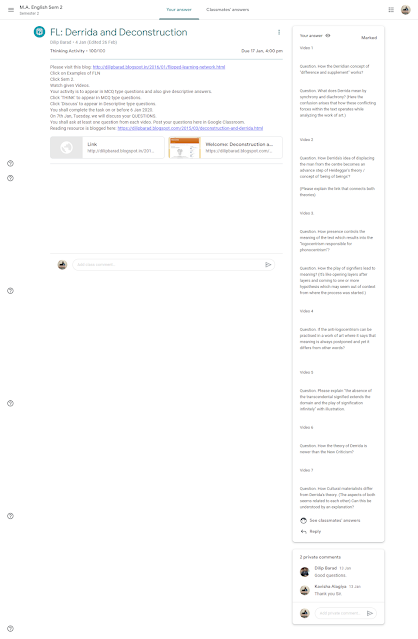Flipped Learning
Welcome Readers,
This blogpost reflects my personal learning experience of Flipped Learning. I found this approach of learning as a student-centred approach. I also strongly believe that if a student has personally participated in this specific type of learning course with great involvement then s/he is surely going to favour this approach because students can learn from their home and learn to solve some obvious problems. If the students face doubts, it can be answered immediately by the teacher. And because of this prior learning, the teacher gets enough time in the classroom to explore new areas/ concepts/ subjects which can generate further productive discussion.

https://flippedlearning.org/wp-content/uploads/2016/07/FLIP_handout_FNL_Web.pdf
Click on the link to view the teacher's blog on Flipped Learning-
Flipped Learning Network - FLN
In this blog, I have tried to give words to what I found interesting about a
Flipped Learning Classroom?
What have I learned from the Flipped Learning Classroom?
The above-mentioned image shows the revised Bloom’s Taxonomy which best fits the concept of Flipped learning. Earlier, in the traditional classroom, learning such as remembering and understanding used to happen in class. But now the reversed (flipped) learning classroom model has opened a new mode of studying. As the taxonomy says, these activities are done before the class by referring to various resources such as videos, e-content, pdfs, books, etc. so when students are exposed to the higher-order thinking skills in class which involves learning in presence of teacher and teacher's demonstration and also learning with peers.
“One of the greatest benefits of flipping is that overall interaction increases: teacher-to-student, and student-to-student.”
― Aaron Sams, Flip Your Classroom
--- > What have I learned from the Flipped Learning Classroom?
I have learned six lessons in my Master Course which are-
1. Aristotle's "Poetics"
2. Dryden's "Dramatic Poetry"
3. Wordsworth's "Preface to Lyrical Ballads"
4. Eliot's "Tradition and Individual Talent"
5. Derrida's theory of Deconstruction
Click on the following links to navigate to my blog on Derrida's theory of Deconstruction as a part of Flipped Learning tasks.
Derrida and Deconstruction-Question and Answer Format
Deconstruction and Derrida- Thinking activity
6. Existentialism as a Philosophy
Click on the following link to navigate to my blog on Existentialism as a Philosophy
Existentialism: Flipped Learning
In all these lessons the students were supposed to learn from the blog resources and complete certain tasks wherein students are asked to think with regard to the resources and reflect this thinking by writing a blog and asking thoughtful questions.
All the doubts regarding the resources were cleared in the classroom discussion and our professor also explored certain unexplored areas while discussing these questions. Hence, my experience regarding flipped learning is very much enriching.
Conclusion-
Flipped learning provides a great level of versatility in education. It is the most captivating approach to share learning content as a flipped classroom which engages students to have a qualitative approach towards learning.
“Basically the concept of a flipped class is this: that which is traditionally done in class is now done at home, and that which is traditionally done as homework is now completed in class.”
― Aaron Sams, Flip Your Classroom
Thank you.
Works Cited-
Flipped Learning Network (FLN). (2014) The Four Pillars of F-L-I-P™












Post a Comment